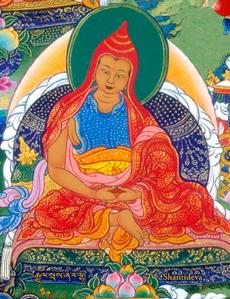Shikshasamucchaya: Difference between revisions
Jump to navigation
Jump to search
No edit summary |
No edit summary |
||
| Line 1: | Line 1: | ||
[[Image:Shantideva.JPG|frame|'''Shantideva''']] | [[Image:Shantideva.JPG|frame|'''Shantideva''']] | ||
The '''''Shikshasamucchaya''''' (Skt. ''Śikṣāsamuccaya'') or ''Compendium of Training'' or ''Compendium of Precepts'' ([[wyl.]] ''bslab pa kun btus'') presents clearly and in detail the conduct that [[Bodhisattva]]s should embrace at all times. Both [[Shantideva]] and [[Nagarjuna]] composed a ''Shikshasamucchaya''. It is the longest of the three texts written by Shantideva, the ''[[Sutrasamucchaya]]'' being the shorter one. The [[Bodhicharyavatara]] is the middle length text, which he chose to teach at [[Nalanda]] university because it was the right length. Nagarjuna's ''Shiksasamucchaya'' is no longer available. Nagarjuna also composed a ''Sutrasamucchaya'' (''Compendium of Sutras'') which can be found in the [[Tengyur]], whereas Shantideva's text of that name has been lost. | The '''''Shikshasamucchaya''''' (Skt. ''Śikṣāsamuccaya'') or ''Compendium of Training'' or ''Compendium of Precepts'' ([[wyl.]] ''bslab pa kun btus'') presents clearly and in detail the conduct that [[Bodhisattva]]s should embrace at all times. Both [[Shantideva]] and [[Nagarjuna]] composed a ''Shikshasamucchaya''. It is the longest of the three texts written by Shantideva, the ''[[Sutrasamucchaya]]'' being the shorter one. The ''[[Bodhicharyavatara]]'' is the middle length text, which he chose to teach at [[Nalanda]] university because it was the right length. Nagarjuna's ''Shiksasamucchaya'' is no longer available. Nagarjuna also composed a ''Sutrasamucchaya'' (''Compendium of Sutras'') which can be found in the [[Tengyur]], whereas Shantideva's text of that name has been lost. | ||
==Outline== | |||
The text has nineteen chapters: | |||
#The paramita of generosity (''sbyin pa'i pha rol tu phyin pa'') | |||
#The paramita of discipline (''tshul khrims kyi pha rol tu phyin pa'') | |||
#Protecting the teacher of Dharma and so on (''chos smras pa la sogs pa bsrung ba'') | |||
#An explanation of harm (''gnod pa bstan pa'') | |||
#Thoroughly abandoning harm (''gnod pa rnam par spang ba'') | |||
#Protecting the body (''lus bsrung ba'') | |||
#Protecting possessions and merits (''longs spyod dang bsod nams bsrung ba'') | |||
#Purifying negativity (''sdig pa sbyang ba'') | |||
#The paramita of patience (''bzod pa'i pha rol tu phyin pa'') | |||
#The paramita of diligence (''brtson 'grus kyi pha rol tu phyin pa'') | |||
#Praise of remaining in solitude (''dgon par gnas par brjod pa'') | |||
#Thoroughly purifying the mind (''sems yongs su sbyang ba'') | |||
#The close application of mindfulness (''dran pa nye bar gzhag pa'') | |||
#Purifying the body (''lus yongs su dag pa'') | |||
#Purifying possessions and merits (''longs spyod dang bsod nams dag pa'') | |||
#Dedication of merit (''dge ba yongs su bsngo ba'') | |||
#The benefits of prostrations and so on (''phyag 'tshal ba la sogs pa'i phan yon'') | |||
#Recollection of the Three Jewels (''dkon mchog gsum rjes su dran pa'') | |||
#Increasing merit (''bsod nams 'phel ba'') | |||
==Translations== | ==Translations== | ||
* | *Śāntideva, ''Śikṣā Samuccaya: A Compendium of Buddhist Doctrine'', translated by Cecil Bendall and W.H.D Rouse, 1922 | ||
[[Category: Texts]] | [[Category: Texts]] | ||
Revision as of 05:48, 17 June 2007

The Shikshasamucchaya (Skt. Śikṣāsamuccaya) or Compendium of Training or Compendium of Precepts (wyl. bslab pa kun btus) presents clearly and in detail the conduct that Bodhisattvas should embrace at all times. Both Shantideva and Nagarjuna composed a Shikshasamucchaya. It is the longest of the three texts written by Shantideva, the Sutrasamucchaya being the shorter one. The Bodhicharyavatara is the middle length text, which he chose to teach at Nalanda university because it was the right length. Nagarjuna's Shiksasamucchaya is no longer available. Nagarjuna also composed a Sutrasamucchaya (Compendium of Sutras) which can be found in the Tengyur, whereas Shantideva's text of that name has been lost.
Outline
The text has nineteen chapters:
- The paramita of generosity (sbyin pa'i pha rol tu phyin pa)
- The paramita of discipline (tshul khrims kyi pha rol tu phyin pa)
- Protecting the teacher of Dharma and so on (chos smras pa la sogs pa bsrung ba)
- An explanation of harm (gnod pa bstan pa)
- Thoroughly abandoning harm (gnod pa rnam par spang ba)
- Protecting the body (lus bsrung ba)
- Protecting possessions and merits (longs spyod dang bsod nams bsrung ba)
- Purifying negativity (sdig pa sbyang ba)
- The paramita of patience (bzod pa'i pha rol tu phyin pa)
- The paramita of diligence (brtson 'grus kyi pha rol tu phyin pa)
- Praise of remaining in solitude (dgon par gnas par brjod pa)
- Thoroughly purifying the mind (sems yongs su sbyang ba)
- The close application of mindfulness (dran pa nye bar gzhag pa)
- Purifying the body (lus yongs su dag pa)
- Purifying possessions and merits (longs spyod dang bsod nams dag pa)
- Dedication of merit (dge ba yongs su bsngo ba)
- The benefits of prostrations and so on (phyag 'tshal ba la sogs pa'i phan yon)
- Recollection of the Three Jewels (dkon mchog gsum rjes su dran pa)
- Increasing merit (bsod nams 'phel ba)
Translations
- Śāntideva, Śikṣā Samuccaya: A Compendium of Buddhist Doctrine, translated by Cecil Bendall and W.H.D Rouse, 1922